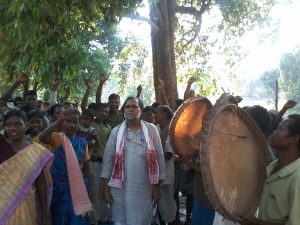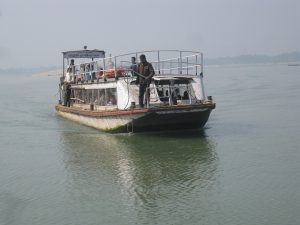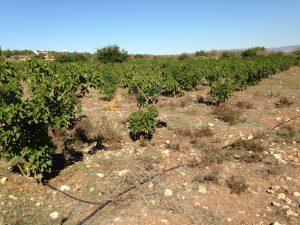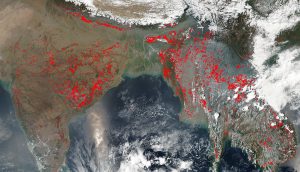The big disappointment during Bangladesh Prime Minister Sheikh Hasina’s visit to India last weekend was the failure to finalise the Teesta water sharing agreement between the two countries. Data available with thethirdpole.net shows this was because the river now has only one-sixteenth of the water needed for agriculture by the two countries during the dry season, from February to May. Little wonder that West Bengal Chief Minister Mamata Banerjee opposed the agreement tooth and nail.
There is no water
In a recently prepared internal report on the Teesta, seen by thethirdpole.net, the West Bengal government states, “Two barrages on Teesta, at about 100 km from each other, in India and Bangladesh were planned to cater [to] irrigation in more than 16 lakh [1.6 million] hectares of land together; around 9.2 lakh [920,000] hectares in [the] state of West Bengal in India and 7.5 lakh [750,000] hectares in Bangladesh. According to a rough calculation, such a scale of irrigation for boro crop (dry season paddy) will require around 1600 cumec (cubic metre per second) of water; while through much of the dry period the river hardly has 100 cumec of water, i.e. one sixteenth of total water requirement in [the] two countries.”
India has a barrage on the Teesta at Gojoldoba at Jalpaiguri district of West Bengal, a little upstream of the point where the river enters Bangladesh. The Bangladesh government has a barrage at Doani in Lalmonirhat district, before the Teesta joins the Brahmaputra.
In recent years, water volume in the Teesta has gone below the 100 cumec level in peak summer, April and May.
Recognising the lack of adequate water in the Teesta, a committee of the West Bengal government under Indevar Pandey, principal secretary of the public works department, has recently decided that the state will irrigate only 52,000 hectares with the river’s water, a reduction over 90% from the original plan.
The data explains Banerjee’s reluctance to part with any water from the Teesta despite pressure from prime ministers of both India and Bangladesh. “Where is the water in the Teesta?” asked the chief minister whenever faced with Bangladesh’s claim for an equitable share of Teesta water.
Key reason – planning failure
Barrages are built to hold back water for the dry season. The West Bengal government report says there is no water in them now, because the water has been released at the wrong time by authorities in both India and Bangladesh.
“While the barrages were planned primarily to provide supplementary irrigation support to aman paddy cultivation during monsoon, subsequently both barrages were used to support boro cultivation during dry season, when there is minimum water in [the] river,” says the report.
The fact that the barrages do not have any water reservoir facility, also compels authorities to release most of the monsoon water rather than keep it back for dry seasons.
All this makes a water sharing treaty even more difficult, though Bangladesh has agreed to a 50:50 split instead of seeking a guaranteed volume of water.
In Bangladesh, a recent study conducted by the International Food Policy Research Institute (IFPRI) and the Centre for Agri-research and Sustainable Environment & Entrepreneurship Development (CASEED) also talked about the shift from monsoon to dry paddy cultivation in the region watered by the Teesta. “A few years ago, the aman rice crop used to be cultivated on 80% of the land but the trend has changed now,” said an expert involved in the project.
The Sikkim effect
Noted river expert Kalyan Rudra pointed out another big problem – the large number of hydroelectric projects already commissioned or under construction in Sikkim state along the Teesta, upstream of West Bengal. These are run-of-the-river projects, so they are not supposed to hold back water. But, Rudra said, “Though these hydropower units release the water, but the timing is not coordinated with the peak time need of farmers.” Large stretches of the river are being cut off due to this poor management, he added.
Still, Bangladesh needs water
Experts in Bangladesh are aware of these problems. Still, they feel, India should release some water from the Teesta during the dry season. “Every country downstream has the right over water as well and despite reduced water volume in summer West Bengal should not oppose release of some water to Bangladesh,” Ainun Nishat, noted river expert and with BRAC University in Bangladesh, told thethirdpole.net.
Nishat pointed out that till 2011, when Mamata Banerjee came to power in West Bengal, Bangladesh used to receive some water from the Teesta all through the year. Now it reportedly receives only about 20 cumec of water in peak dry season, mainly through a tributary called Dhorla, which joins the Teesta downstream of the Gojoldoba barrage.
Need for cooperation
While the West Bengal government report has enabled Banerjee to stymie the India Bangladesh pact for now, even officials of the West Bengal government are not happy with the current state of affairs.
They point out that drying up of a transboundary river just upstream of an international border is contrary to global norms. “What will happen if tomorrow Bhutan or Nepal refuses to part with upstream water?” asked a senior official in the state government.
History of agreement
In July 1983, there was a temporary agreement between India and Bangladesh on the Teesta. It gave 39% of the water to India and 36% to Bangladesh, while the rest was to flow free. The trouble was that this was only a two-year agreement. After that, gradual decline in water flow, particularly in summer, has complicated the situation. Subsequent agreement drafts have suggested similar shares, but they remain drafts.
Teesta the bargaining tool
Of course, the political tussle between India’s Prime Minister Narendra Modi’s Bharatiya Janata Party (BJP) and West Bengal Chief Minister Mamata Banerjee’s Trinamool Congress complicates matters. “I cannot say anything as the chief minister is looking into the issue herself,” said Rajib Banerjee, irrigation minister of West Bengal, when asked about the situation.
This tussle predates Modi’s appointment as Prime Minister. It started in 2011 when then Prime Minister Manmohan Singh had almost finalised a Teesta water sharing agreement on the eve of a visit to Dhaka, and wanted to take Banerjee along. The Chief Minister pulled out of the trip at the last moment and stymied the pact.
In 2015, Banerjee did go to Dhaka along with Modi, and indicated that progress had been made on the Teesta agreement. But now, the BJP-Trinamool relationship is at a low, and the effect was apparent during Sheikh Hasina’s trip.
Water from other rivers?
However, Banerjee knows she cannot keep denying water to Bangladesh, a country that shares 57 rivers with India. “I am all for giving water to Bangladesh but not from the Teesta, as it is the lifeline of north Bengal and does not have enough water to be shared with Bangladesh. Instead I proposed to both Prime Ministers to undertake a study whether water can be given to Bangladesh from other rivers from the region like Torsa, Jaldhaka or Raidak,” she said last weekend.
But neither Dhaka nor New Delhi seems to have taken this idea seriously. River experts also wonder how this is supposed to work. “These rivers are tributaries of the Brahmaputra. Rerouting their water to the Teesta command area in Bangladesh’s will be a herculean task, if not an impossible one,” said a senior official in the West Bengal government.
Despite last weekend’s setback, Hasina and Modi expressed confidence that a Teesta deal will be reached soon. Experts say they may be basing their confidence on a part of India’s river interlinking scheme, under which water from the Manas river (a tributary of the Brahmaputra in Assam) is planned to be transferred to the Ganga via the Sankosh and Teesta rivers. “There is already a proposal of Manas–Sankosh–Teesta interlinking under the national water transfer project and necessary quantity of water may be given to Bangladesh by diverting water from Manas and Sankosh through link canal to Teesta; which will solve the problem of providing adequate water to Bangladesh during dry months,” said Nilanjan Ghosh, an ecological economist and a river analyst associated with the Observer Research Foundation.
Ghosh however added that execution of such a plan would be ecologically disastrous, unsustainable for river health and detrimental to ecosystem services and livelihoods in the long run. “Execution of such a plan will require cutting canals through forest areas which may be extremely damaging,” Rudra pointed out.




![Arctic ice continues to melt, we must approach the challenge with some hope [image by: NASA/Kathryn Hansen]](https://dialogue.earth/content/uploads/2017/04/Arctic-ice-NASA-300x200.jpg)



